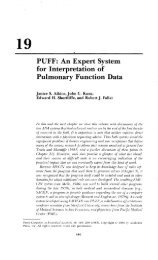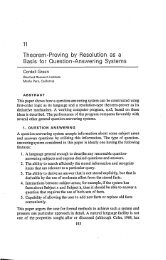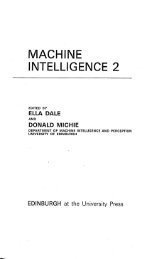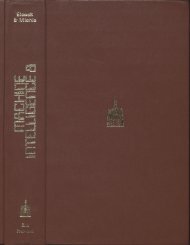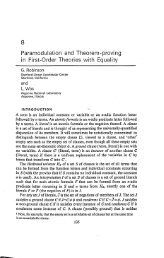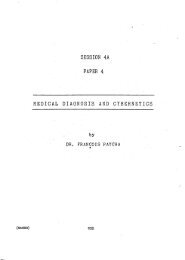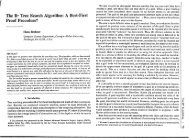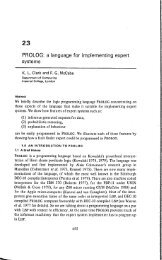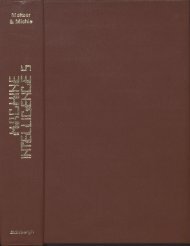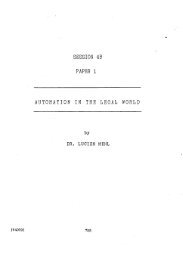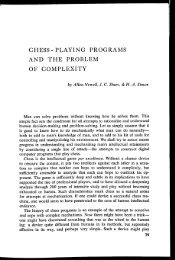Design of low-cost equipment for cognitive robot research - AITopics
Design of low-cost equipment for cognitive robot research - AITopics
Design of low-cost equipment for cognitive robot research - AITopics
You also want an ePaper? Increase the reach of your titles
YUMPU automatically turns print PDFs into web optimized ePapers that Google loves.
29<br />
<strong>Design</strong> <strong>of</strong> Low-Cost Equipment <strong>for</strong><br />
Cognitive Robot Research<br />
H. G. Barrow and S. H. Salter<br />
Department <strong>of</strong> Machine Intelligence and Perception<br />
University <strong>of</strong> Edinburgh<br />
MARK I DEVICE<br />
A minimal :<strong>robot</strong>,Icnown as Freddy, has been constructed with the aim <strong>of</strong><br />
connecting a usable device on-line to the Department's lc L 4130, under the<br />
Multi-Pop time-sharing system, and discovering the snags. ( See figure 1).<br />
Figure 1. Freddy Mark 1 and his world<br />
Various technical problems arise when such a device runs free. It is much<br />
easier to anchor it and al<strong>low</strong> it to push its world about. Our present world is a<br />
three-foot diameter sandwich <strong>of</strong> hardboard and polystyrene which is light<br />
and rigid. It rests on three steel balls and is moved by wheels driven by small<br />
555
PRINCIPLES FOR DESIGNING INTELLIGENT ROBOTS<br />
stepping motors, mounted on the <strong>robot</strong>. Provided that the weights <strong>of</strong> <strong>robot</strong><br />
and slab are chosen correctly, a wide range <strong>of</strong> movements is possible. When<br />
stimulated, the motors drive <strong>for</strong> about half a second, causing the device to<br />
move about 5 mm or turn through about 4°.<br />
A pair <strong>of</strong> bumpers, one in front, one behind, operate two micro-switches<br />
to signal contact with obstacles. A television camera mounted vertically sees<br />
the world through a 45 degree mirror. A wide angle lens provides extremely<br />
large depth <strong>of</strong> field — about 1 in. to 3 ft at reasonably high light levels.<br />
Television techniques are not particularly suitable <strong>for</strong> application to<br />
computer eyes, but as we already owned a closed circuit system, the <strong>cost</strong> <strong>of</strong><br />
the project so far has been very <strong>low</strong>.<br />
We have built the circuitry to sample and hold the instantaneous amplitude<br />
<strong>of</strong> the video signal at any point in the picture. The acquisition time is about<br />
50 nanoseconds, which gives a horizontal resolution rather better than the<br />
vertical line resolution. Voltage levels from simple D—A converters set the<br />
X and Y coordinates and a simple A—D converter codes the sampled level<br />
<strong>for</strong> transmission to the computer. Bright-up pulses are added to the video<br />
signal to produce a cross superimposed on the monitor picture, to show an<br />
observer the position in the picture under study.<br />
From the nature <strong>of</strong> television it is impossible to take fresh measurements<br />
'upstream' without waiting <strong>for</strong> a new frame. If only a single measurement is<br />
made on each frame the data rate is prohibitively s<strong>low</strong>. It may be possible to<br />
achieve random scanning by using the RCA Alphechon tube, in which one<br />
gun writes a picture on a charge storage screen, which may be read nondestructively<br />
by a second gun.<br />
The camera system which we have now is past its prime, and has a particularly<br />
poor signal-to-noise ratio, which can be seen as 'snow' on the monitor.<br />
A good system should be able to make measurements to about 1 per cent,<br />
whereas in this one the noise is about 5 per cent <strong>of</strong> maximum brightness.<br />
Control is effected through an 8-bit, loadable command register, and an<br />
8-bit readable conditions register.<br />
General-purpose interface<br />
Communication between Freddy and the IC L4130 is via a general-purpose<br />
interface. The aim <strong>of</strong> the design <strong>of</strong> the interface was to provide a high speed<br />
data channel through a 'bomb-pro<strong>of</strong>' socket so that a number <strong>of</strong> different<br />
devices (including Freddy) could be connected or disconnected at will. The<br />
Mark I interface possesses the fol<strong>low</strong>ing features:<br />
High speed. It is capable <strong>of</strong> operation at over 500,000 8-bit characters per<br />
second, but is limited by the IC L 4130 transfer rate to about 300,000 characters<br />
per second.<br />
Robustness. It will withstand even the application <strong>of</strong> 240 V mains to its<br />
input without permitting the signals to the IC L4130 to exceed their specified<br />
limits.<br />
556
BARROW AND SALTER<br />
Long-range operation. Devices have operated reliably at over 300 ft from the<br />
computer. Maximum length <strong>of</strong> the connecting cable has not yet been<br />
determined.<br />
Compatibility. The Mark I interface uses the same logical signals as a standard<br />
c 4130 interface channel. It could, in principle, be used to operate a<br />
standard lc L4100 peripheral remotely.<br />
Expandability. The Mark I interface is logically 'transparent' and <strong>of</strong> modular<br />
construction. Provision has thus been made <strong>for</strong> the incorporation <strong>of</strong> a logic<br />
module in the Mark II version to detect error states and take appropriate<br />
action, and also to per<strong>for</strong>m certain simple operations.<br />
The interface and its protection system have been approved by IcL;<br />
devices connected via the interface do not now need approval.<br />
The interface and Freddy control logic have now correctly per<strong>for</strong>med over<br />
65 million operations, during normal public Multi-POP sessions.<br />
Computer communications<br />
Data transferred between Freddy, the device, and the 4130 is in the <strong>for</strong>m <strong>of</strong><br />
single word transfers <strong>of</strong> 8 bits (0 D Um or IDIOM).<br />
The POPMESS facility in Multi-Pop gives the user a function doublet<br />
which outputs the least significant 8 bits <strong>of</strong> an item, or inputs a word from<br />
the <strong>robot</strong>.<br />
e.g. POPMESS([ROBOT])--+RFN;<br />
X -+RFNO;<br />
<strong>for</strong> output,<br />
or RPI■10—>x; <strong>for</strong> input.<br />
We now come to the decoding <strong>of</strong> commands and the encoding <strong>of</strong> sensory<br />
input.<br />
Output words<br />
The most significant two bits <strong>of</strong> the 8 bit word specify the command type:<br />
I I I I<br />
0 0 Y coordinate<br />
I1i I<br />
1 1 1 1<br />
0 1 X coordinate<br />
1 I I I<br />
I I I<br />
1 0 ignored<br />
I I I<br />
1 1<br />
1 1 L R ignored<br />
1 I<br />
557<br />
Set Y and sample picture.<br />
Set X.<br />
Reset motors.<br />
Drive motors. L, R refer to left and<br />
right motors respectively. 1 means<br />
<strong>for</strong>ward, 0 means reverse.
PRINCIPLES FOR DESIGNING INTELLIGENT ROBOTS<br />
The commands 00 and 01 cause the least significant 6 bits <strong>of</strong> the word to be<br />
loaded into the Y or X coordinate register. The 00 command initiates the<br />
sampling <strong>of</strong> the picture.<br />
The third and fourth significant bits <strong>of</strong> the 11 command specify the directions<br />
<strong>of</strong> drive <strong>of</strong> the two motors. When the 11 command is given, the motors<br />
are started. No further commands may be given until motion has ceased,<br />
when the 10 reset command must be given be<strong>for</strong>e another move can be made.<br />
Input word<br />
The input word is structured as fol<strong>low</strong>s:<br />
I I i<br />
Motor Left Right Picture Comparator<br />
flag bump bump flag outputs<br />
I l I<br />
The motor flag is cleared to 0 when the drive command is given, and is<br />
reset to 1 when motion ceases.<br />
Bumper flags are 1 if in contact with an object.<br />
The picture flag is cleared by the set Y command, and is reset to 1. when<br />
the sample has been taken.<br />
The four least significant bits give the states <strong>of</strong> the threshold circuits. Five<br />
brightness levels are discriminable:<br />
0000= 0 decimal= level 0<br />
0001= 1 )<br />
1<br />
0 1 1 = 3 = „ 2<br />
0111= 7 = 3<br />
1111=15 = „ 4<br />
Level 0 is black, level 4 is white.<br />
Programming practicalities<br />
Motors. The sequence <strong>of</strong> operations <strong>for</strong> taking a step or making a turn are<br />
as fol<strong>low</strong>s:<br />
I. Give the appropriate 11 drive command.<br />
2. Wait several milliseconds <strong>for</strong> the motor flag to fall.<br />
3. Monitor the flag and wait <strong>for</strong> it to rise again.<br />
4. Give the 10 reset command.<br />
5. Wait <strong>for</strong> about 1- second <strong>for</strong> the drive circuitry to recover.<br />
The waits (steps 2 and 5) can be implemented by the simple function:<br />
FUNCTION WAIT N;<br />
L: N-1-4N; IF N> 0 THEN GOTO L CLOSE;<br />
END;<br />
558
BARROW AND SALTER<br />
wm T(100) is sufficient <strong>for</strong> operation 2. wa IT (700) <strong>for</strong> 5. To save central<br />
processor time during the flag monitoring, the SWAPOFF system function<br />
(which swaps the user <strong>of</strong>f the time-sharing system) should be used thus:<br />
L: .SWAPOFF;<br />
IF NOT(LOGAND(.RFN, 8:200)) THEN GOTO L CLOSE;<br />
Picture sampling. The sequence <strong>of</strong> operations is as fol<strong>low</strong>s:<br />
1. Set X coordinate with 01 command.<br />
2. Set Y and initiate with 00 command.<br />
3. Monitor picture flag until it returns TRUE.<br />
4. Read and decode picture intensity.<br />
In this case it is not necessary to use SWAPOFF in the monitoring loop in<br />
3 above.<br />
Y runs from 0 to 63 from the bottom <strong>of</strong> the picture upwards.<br />
X runs from 0 to 63 from left to right in the real world (from right to left<br />
on the TV monitor picture).<br />
If the picture is sampled randomly, on the average it will be necessary to<br />
wait 10 msec <strong>for</strong> the picture scan to reach the chosen point (since the frame<br />
time is 20 msec). The time taken to sample all the available 4096 points is<br />
thus 40.96secs.<br />
If the picture is scanned horizontally, row by row, this is almost the worst<br />
possible case. The wait <strong>for</strong> each point is now nearly 20 msec, and the overall<br />
time to read all the points is 81.92 sec.<br />
A suitable scanning scheme calf markedly reduce these times. By setting<br />
X and sampling at several values <strong>of</strong> Y from top to bottom it is possible to<br />
race the TV scan down the picture and take at least 10 samples per frame<br />
(20 msec). (The command structure has been chosen <strong>for</strong> maximum speed;<br />
as the most significant two bits <strong>of</strong> the set Y command are zero, simply<br />
outputting the Y coordinate will initiate the sample.) In this way, the time<br />
taken to read the whole picture can be less than 8 seconds, the actual time<br />
depending upon the amount <strong>of</strong> computing between samples.<br />
PROPOSALS FOR MARK II DEVICE<br />
Our present Mark I is about the simplest possible machine and, as expected,<br />
is becoming obsolete. Its mechanical drawbacks are as fol<strong>low</strong>s:<br />
(1) There are several awkward restrictions on possible movements. It cannot,<br />
<strong>for</strong> example, move to the perimeter <strong>of</strong> the world and then do an about turn.<br />
(2) Rotating movements are s<strong>low</strong> because <strong>of</strong> the high inertia <strong>of</strong> the world.<br />
(3) It is not possible to move directly sideways. It has to: left turn, <strong>for</strong>ward,<br />
right turn. This makes building up pictures <strong>of</strong> an object from all sides very<br />
s<strong>low</strong>.<br />
We have considered many schemes <strong>for</strong> overcoming these drawbacks. The<br />
overall scheme is now complete and many <strong>of</strong> the details are decided.<br />
559
PRINCIPLES FOR DESIGNING INTELLIGENT ROBOTS<br />
Mark II will retain the anchored <strong>robot</strong> principle <strong>for</strong> translations. The<br />
'world' will consist <strong>of</strong> a five foot square <strong>of</strong> aluminium honeycomb or,<br />
perhaps, the present hardboard /polystyrene sandwich mounted on a compound<br />
XY slide. The slides will be rails <strong>of</strong> 2+ x light alloy with ball bearing<br />
constraints. The drive will be through stainless steel multi-strand wires from<br />
two static servomotors. The swept area will be 10 foot square. Maximum<br />
acceleration will be 0.1 g up to a speed <strong>of</strong> 10 inches /sec.<br />
Above the world will be a bridge from which may be slung various eyes, or<br />
bodies. If rotations are required they will have to be done on this bridge.<br />
Several designs are being considered: In the simplest a single small camera<br />
mounted on a rotating vertical mast will be limited to the number <strong>of</strong> rotations<br />
al<strong>low</strong>ed by its cable. A second possibility is the use <strong>of</strong> periscope optics in<br />
which the entrance element is rotated to cover a panorama and the resultant<br />
rotation <strong>of</strong> the picture removed with a half speed dove prism. This al<strong>low</strong>s<br />
complete freedom <strong>of</strong> movement and uses little space in the world at the <strong>cost</strong><br />
<strong>of</strong> optical complexity. It seems rather difficult but not impossible to extend<br />
the principle to binocular vision.<br />
The third possibility is an integrated hand/eye / body system. It seems<br />
clear that fairly good range finding is wanted, and that there is a need <strong>for</strong><br />
higher acuity at points <strong>of</strong> interest. These needs would be satisfied with some<br />
<strong>for</strong>m <strong>of</strong> triclops arrangement as shown in figure 2.<br />
Figure 2. Three cameras <strong>for</strong> foveae and convergence ranging.<br />
A is a television camera fitted with a wide angle lens, say 10 mm, which<br />
provides <strong>low</strong> acuity in<strong>for</strong>mation <strong>of</strong> intensities over a 256 x 256 matrix on a 6<br />
bit grey scale. This camera might well be a Pye Lynx, which could use a<br />
slightly improved version <strong>of</strong> our present Mark I sampling and conversion<br />
circuitry. Its function is to provide modest acuity wide angle coverage,<br />
similar to peripheral vision in humans.<br />
560
BARROW AND SALTER<br />
On either side <strong>of</strong> this central camera are two others D and c, which are<br />
fitted with narrow angle lenses, say 100 mm, to provide the high acuity vision<br />
<strong>of</strong> the foveae. These cameras should really have image dissection tubes, but<br />
perhaps we may have to manage with vidicons. An actuator coupled to both<br />
outer cameras will cause them to rotate about vertical axes and so converge<br />
on objects at various distances. The angle <strong>of</strong> convergence necessary to fuse<br />
the two images will be a measure <strong>of</strong> the distance <strong>of</strong> the object. The moment<br />
<strong>of</strong> fusion is detected by a high positive correlation between the two video signals.<br />
It seems to be much more efficient to correlate outside the computer, using<br />
stochastic multipliers. In order to maintain focus over the required range <strong>of</strong><br />
distance with such narrow angle lenses, it will be necessary to accommodate<br />
the outer pair <strong>of</strong> eyes. The cams and linkages required will be quite simple.<br />
The foveae cover small areas in the centre <strong>of</strong> the field. In order to examine<br />
and range any part, it is necessary to per<strong>for</strong>m some sort <strong>of</strong> head movement,<br />
but be<strong>for</strong>e discussing this one should consider hands.<br />
Figure 3 shows two pantograph linkages. The motion <strong>of</strong> x is a linear<br />
combination <strong>of</strong> the motions <strong>of</strong> P1 and P2, provided that P1 and P2, and x are<br />
co-linear. If pi, and PI are moved away from each other, then H and re move<br />
towards each other. If P2 and p move together in the directions shown, then<br />
H and le are extended. If the palms <strong>of</strong> the hands are to be kept parallel then<br />
a secondary linkage will be necessary. The advantage <strong>of</strong> the pantograph<br />
linkage is that both actuators are static and well away from the palm position.<br />
Now imagine that the eye and hand assemblies are built separately on chassis<br />
a little larger than <strong>of</strong>fice filing boxes. In figure 4 the two chassis are joined<br />
by links at each side. Each chassis can be rotated relative to the link, which<br />
will al<strong>low</strong> the centre <strong>of</strong> the hand area to be moved vertically as seen by the<br />
eyes.<br />
Figure 3. Pantograph arms<br />
00 561
PRINCIPLES FOR DESIGNING INTELLIGENT ROBOTS<br />
The link itself is able to rotate about Its mid point on a bearing supported<br />
by a vertical <strong>for</strong>k. The <strong>for</strong>k hangs from a large horizontal beam and can<br />
rotate about a vertical axis. These last two motions are equivalent to body<br />
movement with eye and hand relatively locked. If this <strong>equipment</strong> is slung<br />
over the X Y table, we will have the minimum number <strong>of</strong> degrees <strong>of</strong> movement<br />
<strong>for</strong> free activity.<br />
Figure 4. A possible hand/eye arrangement<br />
PRIMITIVE COMMANDS<br />
The fol<strong>low</strong>ing is an excerpt from the documentation provided with our Departmental<br />
Multi-Pop consoles.<br />
POP-2 PROGRAM LIBRARY<br />
PROGRAM SPECIFICATION<br />
PROGRAM NAME LIB ROBOT PACK<br />
SOURCE<br />
H.G. BARROW, DMIP.<br />
DATE OF ISSUE September 1969<br />
562
BARROW AND SALTER<br />
Description<br />
This package contains a set <strong>of</strong> basic functions <strong>for</strong> on-line operation <strong>of</strong> the<br />
receptors and effectors <strong>of</strong> the Mark I version <strong>of</strong> the <strong>robot</strong> Freddy.<br />
How to use the program<br />
The package assumes that the function variable ROBOTDATA has been<br />
assigned the repeater function <strong>for</strong> the <strong>robot</strong>, so that this must be done be<strong>for</strong>e<br />
the package is compiled, namely:<br />
VARS FUNCTION ROBOTDATA ;<br />
POPMESS([[ROBOT ]])--,ROBOTDATA; where is the time in<br />
minutes <strong>for</strong> which the<br />
<strong>robot</strong> is required.<br />
Note that the result <strong>of</strong> this POPMESS is a doublet <strong>for</strong> both inputting from,<br />
and outputting to the <strong>robot</strong>.<br />
The package is then compiled by typing:<br />
COMPILE(LIBRARYULIB ROBOT PACK]));<br />
The fol<strong>low</strong>ing facilities will then be available:<br />
Constants. A number <strong>of</strong> useful constants are defined in the package. They<br />
are listed later.<br />
Touch. There are three Boolean functions which sample the two bumpdetecting<br />
switches:<br />
BUMPLEFTO TRUE if left bumper is operated, else FALSE<br />
BUMPRIGHT 0 99 „ right 99 VI 99<br />
ABUMPO<br />
f) „ either<br />
Note that each bump detector responds to contact in front or behind.<br />
Where the object actually is can be determined by remembering which way<br />
Freddy was moving when the bump occurred.<br />
Movement. There are two movement commands, each giving a Boolean<br />
result:<br />
WALK (< distance in millimetres >) ;<br />
TURN() ;<br />
As moves are in fact quantized, the distance Freddy actually walks may<br />
differ from the specified distance by ±25 millimetres. If the WALK argument<br />
is negative, Freddy moves the specified distance in reverse.<br />
Turns are similarly quantized, and actual angle turned may differ from<br />
that specified by ±0.035 radians. If the argument is positive, Freddy turns<br />
left, if negative he turns right.<br />
The Boolean variable B U MP ON determines whether or not Freddy stops on<br />
contact with an object.<br />
If BUMPON is FALSE, he ignores bumps, and the results <strong>of</strong> WALK and<br />
TURN are always TRUE. (It is thus possible to push objects.)<br />
563
PRINCIPLES FOR DESIGNING INTELLIGENT ROBOTS<br />
If BUMPON iS TRUE, then if no obstacles are encountered, he steps or<br />
turns the full distance and returns the result TRUE. If an obstacle is touched,<br />
he stops immediately and exits from the move function with the result FALSE.<br />
The variable LASTWA LK contains the distance actually moved during the<br />
last call <strong>of</strong> the WALK function. LASTTURN contains the angle turned during<br />
the last call <strong>of</strong> TURN. If no obstacles are encountered, the value will be<br />
approximately equal to the argument <strong>of</strong> the function. If a bump causes exit<br />
from the move function, the value will be the distance actually travelled<br />
(or angle turned) up to the moment <strong>of</strong> impact. (i.e., WALK(-LASTWALK);<br />
Will return Freddy to his starting place be<strong>for</strong>e the last move).<br />
Dead reckoning. The move routines endeavour to maintain a running<br />
estimate <strong>of</strong> Freddy's position and orientation. Position is measured in<br />
Cartesian coordinates, in millimetres. Orientation is measured in radians<br />
and is the angle between the x-axis and the direction in which Freddy is<br />
pointing. The angle is restricted to the range 0 to 2n.<br />
The estimates are held in the variables:<br />
XNOW, YNOW, ANGNOW<br />
(Typing CTRL and G during motion will only introduce an error <strong>of</strong> one<br />
quantum <strong>of</strong> angle or distance.)<br />
The function SETPOSITION(X, Y, THETA); sets the estimates to the<br />
specified values.<br />
The function PRPOSITION(); prints the current values <strong>of</strong> the estimates.<br />
Vision. Note first that the TV camera looks into a mirror. What is seen on<br />
the TV screen is there<strong>for</strong>e a laterally inverted version <strong>of</strong> the real world. The<br />
fol<strong>low</strong>ing refers to the real world and not the TV monitor.<br />
The picture is sampled at one <strong>of</strong> 4096 points in a 64 x 64 array. Bottom<br />
left is (0, 0), top left is (0, 63), top right is (63, 63) and bottom right is<br />
(63,0).<br />
The function PICINT(X, 1); samples the picture at point (x, Y) and<br />
returns an integer value <strong>for</strong> light intensity from 0 to NBRIGHTLEVEL. In<br />
the Mark I <strong>robot</strong>, there are five possible values, 0 to 4. Black is signified by 0,<br />
white by 4.<br />
The function AVINT(X, Y, N) returns the mean over N samples <strong>of</strong> light<br />
intensity at (x, I') to reduce effects <strong>of</strong> noise on the TV signal.<br />
The function DISPLAY(FN, INC, X0, Xi , YO, Y1) prints a picture (via<br />
CUCHAROUT) using the characters:<br />
, t + * N NI to simulate a grey scale.<br />
FN is a function <strong>of</strong> two arguments, which yields a result (integer or real) in<br />
the range 0 to NBRIGHTLEVEL, and INC specifies the increment, and x0, x 1,<br />
YO, Yl specify bounds <strong>for</strong> x and Y.<br />
The function DISPIC is DISPLAY( %0, 63, 0, 63%) and thus will display<br />
the values <strong>of</strong> FN over the entire field.<br />
e.g., DISPIC(PICINT, 8);<br />
564
0/0/00/00/0%%%%%%%%%%%%%%%<br />
0/0<br />
• • %<br />
m m m . %<br />
M m m m m .<br />
+ MM m %<br />
MM MM MM M %<br />
M MM MM N N %<br />
MMMMNMMM%<br />
%%%%%%%%%%%%%%%%%%%<br />
BARROW AND SALTER<br />
The function STATS(FN, INC, X0, xl, YO, Y1) returns mean and standard<br />
deviation <strong>of</strong> the values <strong>of</strong> FN(x , Y) over the range x going from x0 to<br />
xl in steps <strong>of</strong> INC and Y from YO to Yl in steps <strong>of</strong> INC. In particular, FN<br />
may be PICINT or AVINT(%5%) etc.<br />
e.g., STATS(PICINT, 2, 10, 30, 15, 28) -+MEAN—■STDEV;<br />
puts the average light intensity over the window into MEAN and the standard<br />
deviation into STDEV.<br />
The function PRsTATs(FN, INC, X0, Xl, YO, Y1) calls STATS and prints<br />
the results.<br />
If an object can be seen to rest on the world by the <strong>robot</strong>, then the position<br />
(y value) <strong>of</strong> the foot <strong>of</strong> the object on his retina can be translated into a<br />
distance.<br />
The function GPDIST(Y) yields distances, in millimetres, from the wheelbase<br />
to the projection <strong>of</strong> rows on the retina, <strong>for</strong> values <strong>of</strong> Y from 0 to 31, on<br />
the ground plane. (The horizon lies between Y=31 and Y=32.)<br />
Global variables<br />
Useful Constants<br />
PI<br />
TWOPI<br />
WORLDRADIUS<br />
FREDLENGTH<br />
FRED WIDTH<br />
WHEELSEPARATION<br />
EYEHEIGHT<br />
EYEOFFSET<br />
EYEELEVATION<br />
PICANG WIDTH<br />
PICANGHEIGHT<br />
NPICWIDTH<br />
NPICHEIGHT<br />
NBRIGHTLEVEL<br />
3.1416<br />
2*PI<br />
radius <strong>of</strong> Freddy's world, in mm.<br />
length <strong>of</strong> Freddy from front to back, in mm.<br />
overall width <strong>of</strong> Freddy, in mm.<br />
separation <strong>of</strong> wheels, in mm.<br />
height <strong>of</strong> eye above ground, in mm.<br />
distance <strong>of</strong> lens in front <strong>of</strong> axle (actually negative), in mm.<br />
angle <strong>of</strong> elevation <strong>of</strong> view, radians.<br />
angular width <strong>of</strong> picture sampling array, in radians.<br />
„ height )7 ft ft<br />
number <strong>of</strong> sampling positions across picture —1.<br />
$9 29 down „ —1<br />
number <strong>of</strong> distinguishable brightness levels —1.<br />
[continued<br />
565
PRINCIPLES FOR DESIGNING INTELLIGENT ROBOTS<br />
Useful Constants (contd.)<br />
MMPER WALK quantum <strong>of</strong> <strong>for</strong>ward motion, mm.<br />
MMPERBWALK ,, „ backward „ „ (negative)<br />
RADPERLTURN ,, „ left turn, radians.<br />
RADPERRTURN Pf „ right f t<br />
„ (negative)<br />
PICHAR (0 to 7) array, holding characters printed <strong>for</strong> grey scale.<br />
Useful Variables<br />
XNOW, YNOW, ANGNOW current estimates <strong>of</strong> position and orientation.<br />
LAST WALK distance travelled during last call <strong>of</strong> WALK, MM.<br />
LASTTURN angle turned during last call <strong>of</strong> TURN, radians.<br />
BU1VIPON if 'TRUE, contact causes exit from move functions.<br />
Useful Functions<br />
ABS<br />
result is absolute value <strong>of</strong> argument.<br />
ABUMP, BUMPLEFT, BUMPRIGHT,<br />
SETPOSITION, PRPOSITION,<br />
WALK, TURN,<br />
PICINT, AVINT,<br />
DISPLAY, DISPIC,<br />
STATS, PRSTATS.<br />
Other Globals<br />
Functions WAIT, FLAG, DRIVE, MOVEPAUSE, MOVEDONE, ANGUPDATE,<br />
WALKUPDATE, MOVEIT, CHARLOTS, ROBOTDATA.<br />
Store used<br />
The compiled program occupied about 4 blocks <strong>of</strong> core.<br />
The uncompiled program occupies 17 sectors <strong>of</strong> disc.<br />
Acknowledgements<br />
The greater part <strong>of</strong> the hardware work was done in the Department's Bionics Research<br />
Laboratory directed by Pr<strong>of</strong>essor R.L.Gregory and the programming and interfacing<br />
work in the Experimental Programming Unit directed by Pr<strong>of</strong>essor D. Michie. The<br />
authors wish to acknowledge financial support from the Nuffield Foundation (S.H.S.)<br />
and from the Science Research Council (H.G.B.).<br />
566



